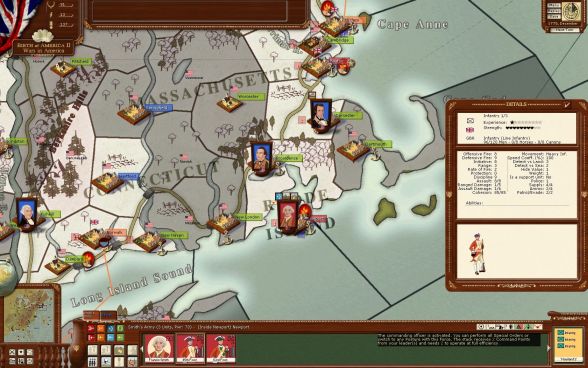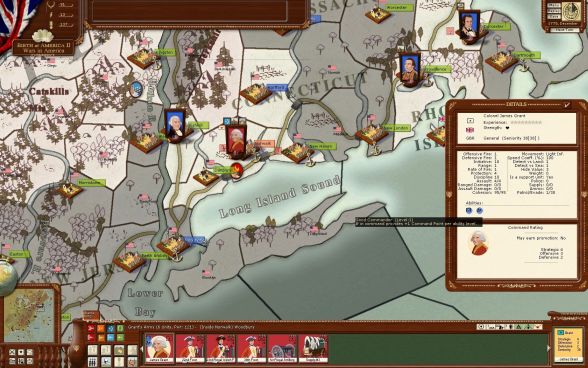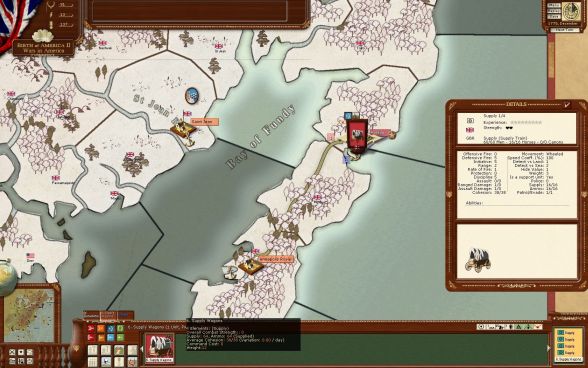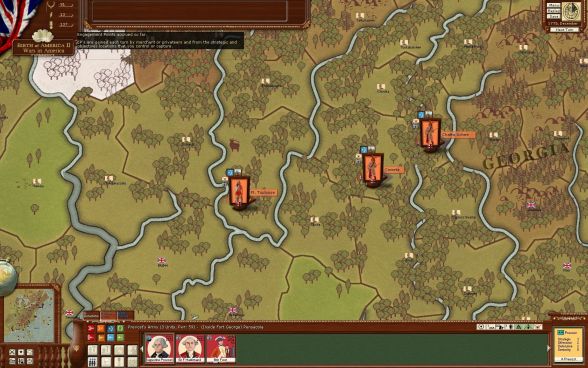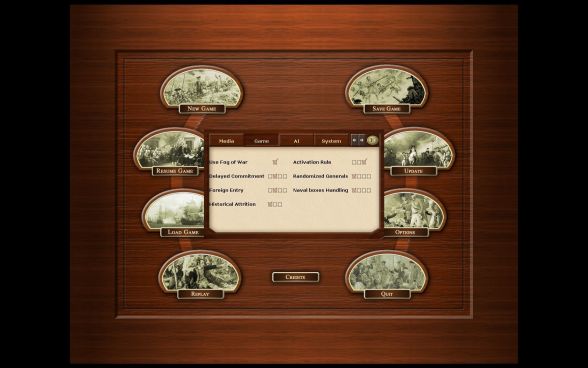Here are
some simple but important tips for those people who download
the demo, and need some directions where to start. I think these tips
could prove very valuable since they will help you to get started and
survive the crucial time when you will have no clue what's going on.
How to get started
[1] Your units are strewn all over the place, so don't make the mistake
and try to click on them one by one. Instead use E or R to cycle
through available land units. You can also use Q and W to cycle through
locked units. T or Y does the same for naval units.
[2] Understanding command points should be your first task. In order to do this, learn about commanders, stacks, and how to check command points and penalties. As a general rule, it is better to have several smaller stacks with optimal command points, than few large ones, and to use them for many small scale scale actions instead of concentrating your forces too much. To illustrate this, the following screenshots show examples of small forces that make use of optimal command and will be much more efficient than large superstacks with command penalty:
below: the typical 1-star general has 2 CP, and can command 2 units. Such a force will not be able to win big battles, but it will be enough to move quickly, take and hold a strategically important position:
[2] Understanding command points should be your first task. In order to do this, learn about commanders, stacks, and how to check command points and penalties. As a general rule, it is better to have several smaller stacks with optimal command points, than few large ones, and to use them for many small scale scale actions instead of concentrating your forces too much. To illustrate this, the following screenshots show examples of small forces that make use of optimal command and will be much more efficient than large superstacks with command penalty:
below: the typical 1-star general has 2 CP, and can command 2 units. Such a force will not be able to win big battles, but it will be enough to move quickly, take and hold a strategically important position:
below: this force with 4 CP and less than 1000 men is small, but packs quite
a punch. Especially as it is coming with it's own artillery and supply.
It should either commanded by a 2-star general or, as in this
particular example, by a 1-star general with additional
bonuses. Instead of a large superstack moving from province,
it is such forces that will win the game for you:
[3] Your second most important task is to understand supply.
Learn about supply level in forts and towns, how to check a stacks
ammunition, food and water state. Supply wagons provide a stack with
it's own mobile supply of food, water and ammuniton, so you should
never send out a large force without at least one supply wagon!
supply wagons
[4] Your third task is to learn about cohesion. Cohesion
represents morale, order and readiness to fight, and is the absolutely
crucial factor in calculating fighting strength. Cohesion
does not represent losses and will diminish fast, long before a unit
has seen actual combat. Especially moving through difficult terrain
will quickly lead to disorder, and very often units are temporarily
incapacitated by bad weather, lack of supply, etc. But it will recover
just as quickly if you move to a fort / town that is reasonably
supplied. No matter if it's clear what I just tried to explain, there
is a very simple message: in no case should you ever start a battle
without knowing about the cohesion level of your armies!
[5] There is this number the game shows next to units, and it represents the approximate fighting strength of a stack / unit. But often it is more insightful to hold the CTRL key while a stack is open: this will instead show the number of men, cannons and horses, which is more intuitive.
[6] There were hardly any roads in North America at the time, and winter weather can be harsh, so never underestimate the importance of terrain and weather.
[7] A lot of units are locked (permanent garrisons etc). So if you see the lock symbol, it means the unit cannot move during this turn, possible not during the whole campaign. Such units are still absolutely useful as garrisons.
[5] There is this number the game shows next to units, and it represents the approximate fighting strength of a stack / unit. But often it is more insightful to hold the CTRL key while a stack is open: this will instead show the number of men, cannons and horses, which is more intuitive.
[6] There were hardly any roads in North America at the time, and winter weather can be harsh, so never underestimate the importance of terrain and weather.
[7] A lot of units are locked (permanent garrisons etc). So if you see the lock symbol, it means the unit cannot move during this turn, possible not during the whole campaign. Such units are still absolutely useful as garrisons.
Locked units/leaders
[8] All AGE games have a so called activation rule that is meant to
simulate psychological effects: generals were often undecided or
incapacitated for a while. Stacks will be heavily penalized
during the time a leader is not active. This is an important gameplay
element, but unfortunately it can be frustrating for the beginner. So
my tip is to disable the activation rule first, before you start
learning the game (this can be done from the options / main menu). But
make sure you have it enabled back if you want to play in earnest,
since it is a very good feature.
game options / activation rule
[9] In the time period the game depicts, defensive tactics are usually
stronger than offensive ones. So if you don't know what to do on the
strategy side, simply form small to medium stacks, and try to maneuvre
them into defensive positions (forts, towns) before your enemy. Then
let him attack if he wants. Don't attack fixed positions yourself until
you know whats going on, and have a decisive superiority in leadership,
quality, and most of all, artillery.
[10] Make use of naval transports! Not only is it faster, but units don't lose a lot of cohesion that way. Land operations can be disastrous in terms of cohesion, but it turns out armies don't always need to march long distances on foot. This is especially so as the British, which have a huge naval superiority and operate on exterior lines. Don't forget that you can move naval transports also on rivers and lakes, which allows you to conduct operations in otherwise inaccessible areas. The logic consequence of this is that one should concentrate on controlling towns which have a port.
[10] Make use of naval transports! Not only is it faster, but units don't lose a lot of cohesion that way. Land operations can be disastrous in terms of cohesion, but it turns out armies don't always need to march long distances on foot. This is especially so as the British, which have a huge naval superiority and operate on exterior lines. Don't forget that you can move naval transports also on rivers and lakes, which allows you to conduct operations in otherwise inaccessible areas. The logic consequence of this is that one should concentrate on controlling towns which have a port.
The game has a huge number of additional facets, but if you start with the things I just said, I think you might stand a good chance to actually get into playing and enjoying the game, and not give up too early.
